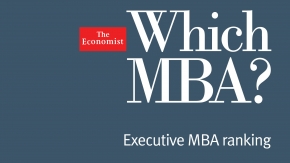Executive MBA ranking
Jul 18th 2013, 12:41by Which MBA?
ONE business school emerges as the clear winner inThe Economist’s first ranking of executive MBA programmes. The Kellogg School of Management at Northwestern University near Chicago has four programmes in the top ten. Number one is its joint programme with Schulich School of Business at York University, just across the border in Ontario, Canada. Programmes run in conjunction with Hong Kong UST and WHU in Germany also make the top ten, and Kellogg’s standalone EMBA is number eight.
Our ranking measures business schools on two broad criteria: personal development/educational experience and career development. Within these categories, we look at 27 criteria, including the quality and diversity of students, the quality of the faculty, the percentage of students who receive a promotion after they graduate and the average salary increase graduates can expect. The data are a mixture of student-reported figures, student ratings and data provided by the schools (seemethodology).
Joint programmes seem to be a particular hit with students. Participants on the Kellogg-Schulich programme gave the highest marks for the quality of their classmates as well as for faculty and facilities. It also came top when alumni were asked the extent to which the programme helped them achieve their pre-MBA career goals. The joint MBA offered by Kellogg and the Hong University of Science of Technology, meanwhile, got the top rank for the overall quality of its students. Students who enrol on this programme are particularly high-powered, earning on average $261,000 with 15 years’ work experience.
It is interesting to note that a school’s joint EMBA will often rank higher than its standalone programme. Kellogg’s single-campus programme, although ranked a creditable eighth, lags behind those offered with partners. The UCLA-National University of Singapore joint EMBA, ranked third, fares better than the standalone programmes at UCLA (11th) or the NUS (43rd). The ESADE-Georgetown EMBA is 12th, whereas the one offered solely at Georgetown is 27th.
One reason for this is that joint programmes are generally more international. The UCLA-NUS EMBA, for example, insists that students take at least four one-week assignments overseas during the programme. Joint programmes also enrol more experienced students. Those on the UCLA-NUS programme will have, on average, three years’ more work experience and earn close to $40,000 more than the UCLA single-campus alternative.
American programmes dominate the ranking. Well over half the programmes on our list are based—solely or partly—in America. But two Spanish schools also perform well. This may come as a surprise, given the travails of that country’s economy. But students on these programmes are often not Spanish residents. The EMBA at IE Business School, ranked second, makes extensive use of distance learning, and face-to-face classes take place in Spain, China and Brazil, so it is not essential for students to be too near at hand. Its programme performs particularly well in the salary category, which is the most heavily weighted in the ranking. IE students reported that their basic salaries had risen by 52% by the time they graduated, from $101,569 to $154,281. Within two years they could expect their salaries to have increased by 125%, more than those of students at any other school. Career advancement is also a big selling point at neighbouring IESE, ranked fifth—88% of its students said that they had either been promoted or grown their company since graduation.
While EMBA students are recruited from around the world and come from a wide variety of industries—18 of the programmes surveyed comprised students from at least 11 different industry sectors—one criterion on which all schools fare badly is the percentage of women students in their classes. None of the schools on our list enrol more women than men. The highest ranked in this regard is Concordia in Canada where 41% of students are women. At IMD in Switzerland it is a desultory 12%. For a degree in which students are said to learn more from their classmates’ experiences than their lecturers’ pontifications, EMBA programmes fall woefully short in this regard.The Economistplans to run this ranking every two years. In this area, at least, we very much hope to report improvement.

